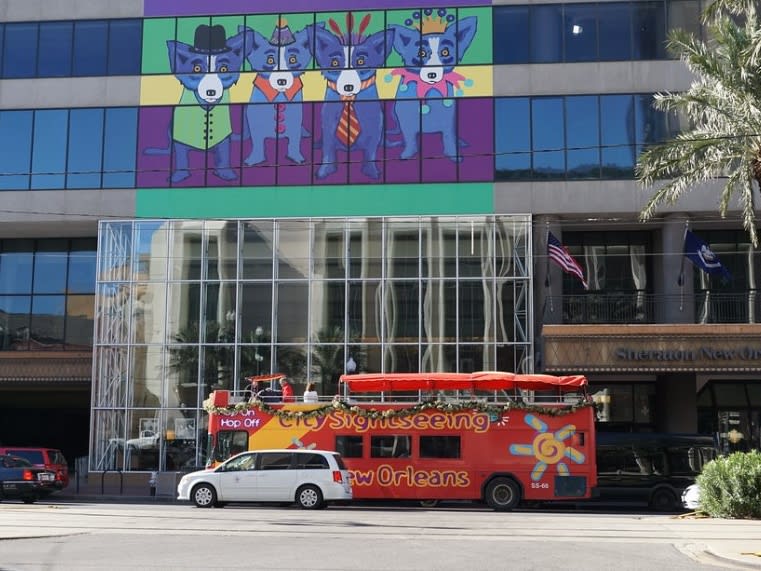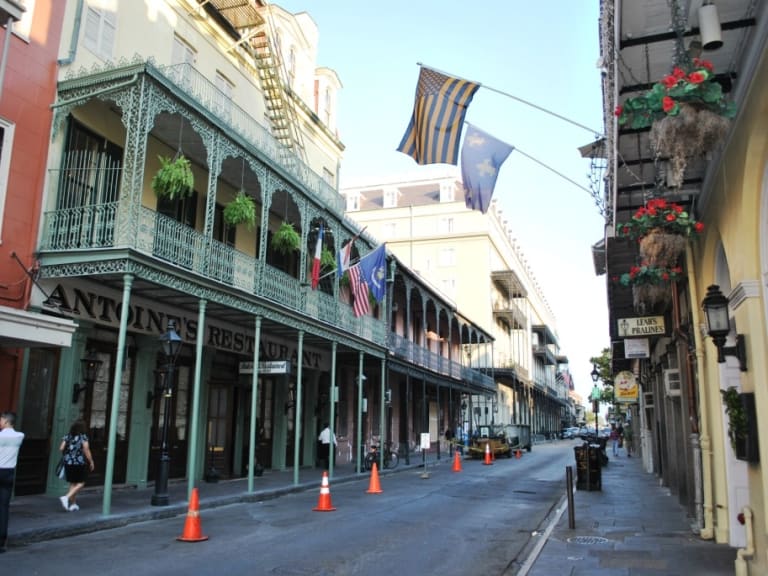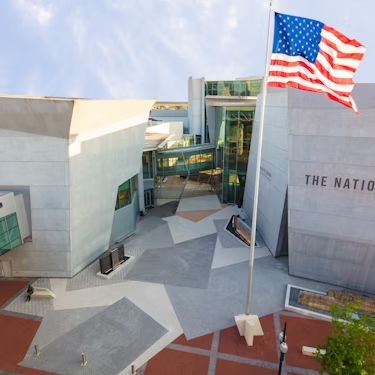More about: Best Things to Do In New Orleans In 4 Days
New Orleans has something to offer every tourist, from beautiful natural attractions to events that celebrate the city's unique culture and cuisine. Of course, there are many things to see and do in New Orleans, but with this four-day itinerary you won't miss a thing.
During these four days you will discover the public side of New Orleans, with tours of its main avenues and neighborhoods (starting with the French Quarter). But you will also get to know the more intimate side of the city, through its flavors (the characteristic Cajun and Creole cuisine), its stories, its religious syncretism and the warmth of its people.
First day: minibus tour to get an overview of the city, tour of Mardi Gras World and dinner on a steamboat.

The itinerary begins with a minibus tour of the city's main points of interest.
The first destination to see is the French Quarter, the city's cultural jewel par excellence.
Then you will continue with a guided visit to Mardi Gras World, an attraction for the whole family. And to end the day, a steamboat tour on the Mississippi.
New Orleans Minibus Tour
Your itinerary starts with a bus tour of New Orleans, which will help you get acquainted with the city's rich history and culture right from the start and in a short time.
The tour lasts about three hours and the seat per person is priced between 28 and 32 euros.
My recommendation is to book the tour that starts at 9 a.m., so that by noon you are free for lunch. An air-conditioned minibus will pick you up directly from your hotel (or a central location in the city) at the agreed time.
The tour usually starts in the French Quarter. During this first stop you will learn about the history of one of the oldest neighborhoods in New Orleans.
Next you will visit City Park, the green lung of New Orleans, the Garden District, famous for its 19th century mansions, the War II Museum and the New Orleans Museum of Art.
The tour closes with the Metairie Cemetery, architectural emblem of the city, and the Saint Louis Cathedral, the oldest cathedral in the United States. At the end of the tour, the bus returns to the starting point of the tour.
Tour Mardi Gras World, the place where the magic of Carnival is made.
It's noon and you're sure to have worked up an appetite. Well, in the French Quarter itself you'll find several options for lunch, but my recommendation is to head to Royal Street (it's on the way to the next attraction on the itinerary), and have lunch at The Court of Two Sisters restaurant; reservations are recommended, but not essential.
After lunch, continue down the street (walking south) and keep an eye out for a right turn onto Coti Steet. From there, uphill, a two-minute walk will take you to the next point on our itinerary: The Mardi Gras World.
Here you will participate in a guided walking tour of Mardi Gras World, a gigantic warehouse where New Orleans' best artists gather to build the most creative floats. (The float parades are perhaps the main attraction of Mardi Gras, New Orleans' carnival.
Mardi Gras World is located on the left bank of the Mississippi River. This tour lasts about an hour and a half and you can reserve your place on it starting at 20 euros.
An important detail is that the transportation for this tour picks you up at least 20 central points in New Orleans.
Throughout the tour of Mardi Gras World, an expert guide will tell you the history of this facility and its relationship with the carnival in the city. Children are also provided with play areas and the chance to see the floats up close. At the end of the tour you can also try a piece of king cake, the typical Mardi Gras food.
Dinner cruise on the Mississippi while listening to a live jazz concert
We end the day with a cruise on the Mississippi aboard a steamboat, a traditional symbol of New Orleans. Both Mardi Gras World and the steamboat port are located on the left bank of the Mississippi River, so a cab can take you from one point to the other in just 10 minutes.
This river tour lasts about two hours and tickets can be purchased from 35 euros.
During this tour you will not only witness the light show that New Orleans presents at night, but you will also enjoy a delicious dinner (or lunch), with typical food of the city, various cocktails, and a live jazz (or steam piano) concert.
Important: the cruise has disabled access, but access to the upper deck is only by stairs. Please take this into consideration when reserving your seat.
Day 2: visit the French Quarter, tour the World War II Museum and the New Orleans Museum of Art

The second day will not be used to visit new attractions, but to make a more extensive tour to three places you already visited the day before: the French Quarter, the World War II Museum and the New Orleans Museum of Art.
To properly enjoy the tourist experiences that each of these destinations offers, it is necessary to visit them with more time and calm. They are also three of the most important historical and cultural sites in the city.
Extended tour of the French Quarter
It takes at least a couple of hours to discover and get to know the French Quarter properly. Adventure lovers may want to explore the hidden corners of this neighborhood on their own, now that they know where it is.
But if you prefer to have a guide, you can also join a historical walking tour of the French Quarter. You can reserve your spot for this guided tour starting at 14 euros. In both cases, I recommend a morning tour.
In addition to its attractive architecture, which includes period houses recognizable by their colorful balconies, the French Quarter also draws attention for being the epicenter of multiple live concerts and colorful parades daily. The latter you can see for yourself when you pass through Jackson Square.
During the tour, those who want to taste the typical food of the city can go to Café de Monde, to have breakfast with beignets and a delicious café du lait. Beignets, for those interested in New Orleans cuisine, are a type of beignet covered in powdered sugar, probably inspired by the French dessert of the same name.
World War II Museum Immersive Tour
At 1 p.m., before lunch, you will head to the city's Central Business District to visit the New Orleans World War II Museum.
I recommend getting there using the old New Orleans Railroad (you can get on near the French Quarter and it costs about 1.25 euros). You should get off at the Lee Circle monument, and walk across Andrew Higgins Boulevard, walking in the direction of the Mississippi River, until you see the museum appear on your left.
Tickets for the museum are available from 29 euros. Once inside, I recommend that you go to the American Sector restaurant (which is on the premises) for lunch and then you can spend some time on your tour.
This World War II Museum in New Orleans offers an immersive experience that teaches visitors from different perspectives about America's involvement in World War II.
The exhibits also seek to explain what the U.S. intervention in this clash meant to the world.
The museum uses interactive routes, accompanied by diverse historical resources; from videos, photographs and oral testimonies, to weaponry, uniforms, among others.
The visit of this itinerary is organized to last between two and three hours, but in case you suffer any delay in your plans for the day, keep in mind that the museum is open until 5 pm.
Visit the New Orleans Museum of Art
Around 3 p.m., exit the World War II Museum and head to Calliope Street to catch the bus to City Park, where your next destination is: the New Orleans Museum of Art. It is one of the most important cultural attractions in the city.
Tickets can be purchased from 8 euros on the official website of the institution.
The exhibitions of this museum cover art from antiquity (highlights the exhibition dedicated to the Egypt of Queen Nefertari, which has more than 220 original pieces), through the pre-Columbian period, to modernity and the contemporary era. From the latter period, a small collection of works by French impressionist painter Edgar Degas stands out.
Other exhibits are dedicated to promoting art made in New Orleans. Note that the museum is open until 6 p.m. on weekdays and until 5 p.m. on Saturdays.
Also, once you leave, if you're hungry, you can head to Ralph's on the Park, a popular Cajun and Creole restaurant across from the park's main exit.
Day 3: Guided tour of the New Orleans swamps and tour of Oak Alley Plantation

On your third day in New Orleans you will visit the swamps on the outskirts of the city (this is the environment where the Cajun culture originated). You will then visit one of Louisiana's most famous plantations.
Combining a tour of the New Orleans plantations with a tour of the city's swamps will result in a lower final price than booking them separately.
Both tours include transportation and a local guide, who will give you multiple facts about the swamp ecosystem and the history of the plantations. This double tour starts around 9 a.m. and lasts about seven and a half hours.
Oak Alley Plantation Guided Tour
Early in the morning, an air-conditioned shuttle will pick you up at your meeting point and take you to Oak Alley Plantation, a sugar plantation complex built in the early 19th century.
Once on site, your guide will give you a tour of the mansion, the plantation's main building. This house is filled with artifacts from the time when large Southern landowners lived there. No pictures are allowed inside the mansion, only from its balconies.
Outside the house you can visit the gardens of the mansion and the fields, which are the plantation itself. In another wing of the complex there is also an exhibit dedicated to informing about the role that slaves played in the development of the plantation.
Before moving on to the second part of the tour you will have time for a snack or lunch. This part of the tour lasts about two hours.
Expedition with a local guide through the swamps of New Orleans
After noon, a shuttle will take you to a private wildlife refuge, located in one of New Orleans' swamps, for a boat expedition through the city's own ecosystem.
Once there, your guide will give you interesting facts about the swamp and the wildlife that inhabits it.
During this tour of the New Orleans swamps you will be able to take wonderful photos of the local wildlife, which includes turtles, raccoons, owls, snakes, wild boars and alligators, and if you dare, you can even catch a baby alligator.
All animal handling, of course, occurs under the supervision of your captain, a Cajun expert in native species.
Your guide will also explain details about the Cajun culture, which emerged when a group of French settled in this territory in the mid-18th century after being expelled from Canada by the English army.
The tour includes a traditional Cajun lunch and a visit to Lake Pontchartrain.
Fourth day: gastronomic tour and drunken stories tour (tour of the best bars in the French Quarter).

On your fourth day in New Orleans you will immerse yourself in a culinary and cultural experience that will give you a first-hand look at the city's culinary highlights and the best spots to celebrate with alcohol.
Both the food tour and the drunken history tour take place within the French Quarter, so you won't lose any time during your transfer from one tour to the other.
Participate in a gastronomic tour of the French Quarter, and discover the most significant places (according to their history) to taste Cajun and Creole food
The city's gastronomy has produced two distinct (but commonalities): Cajun and Creole cuisine.
On your last day here, you'll join a food-focused French Quarter tour that will take you through both culinary traditions. The tour usually starts at 1:30 p.m., 61 per person.
On this culinary tour you will visit Antoine, the oldest restaurant in New Orleans (founded in 1840), and one of the best places to sample Creole food, known for dishes such as beef brisket with horseradish sauce or gumbo.
Creole cuisine employs a wide range of ingredients in its recipes due to the French, Spanish, Italian, Caribbean, and African influences that shaped it. In these dishes you will find ingredients such as flour, smoked ham, chives, grains, rice, among others.
Later you will visit Remoulade's, an essential stop to enjoy Cajun food. This was created by French colonists who settled in the swamps of New Orleans in the 18th century.
This cuisine focuses on dishes made with marine animals (e.g. turtle soup), and uses mostly onions, garlic and peppers.
Join a historical tour of the best bars in the French Quarter and learn about the origins of voodoo in New Orleans
Your itinerary ends with a tour that combines two of New Orleans' top cultural attractions: a tour of must-see pilgrimage destinations to discover voodoo culture and a visit to the best bars in the French Quarter.
The drunken stories tour lasts approximately 2 hours and is priced between 29 and 35 euros.
During the first part of the tour you will visit the house of the voodoo queen, Marie Laveau.
Laveau gained enormous prestige in New Orleans in the 1800s for offering her services as a voodoo priestess. Voodoo is a syncretistic faith, blending elements of West African religions with French Catholicism.
This first part of the tour includes visits to buildings where ghost sightings have been reported.
To conclude, you will take a tour of the best bars in the French Quarter, most of which (both for their historical value and the drinks they serve) are on Bourbon Street.
Here you'll hear more than one story of famous drunks/important city events that started with a night of drinking in the French Quarter.
When is the best time to travel to New Orleans?

During the summer the heat (with temperatures ranging from 34-35°C) and humidity of New Orleans can be a bit harsh for travelers. Because of this, many travelers feel that the best time to travel to New Orleans is not in the middle of summer.
So what is the best time? Public opinion agrees that there are two periods of cool weather when it is ideal to visit New Orleans: late March through the first half of May and early October through mid-November.
Handicapped accessible activities

In this itinerary there are some activities that do not have the necessary infrastructure to include people with physical disabilities (such as limited movement).
For this reason, if you or any of your companions have a disability, it is important that you notify the company that organizes the activity in which you wish to participate, in advance. This way you will be able to enjoy your plans without any setbacks.




